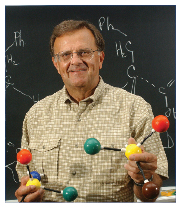In a departure from the thematic approach I’ve taken in my previous letters in the Blue Hen Chemist, I’ve decided, this year, to touch on a number of different developments involving our undergraduate program.
Bursting at the Seams
During the first 6 years of the 21st century, the fall offering of our largest course, CHEM-103 General Chemistry, averaged a large, albeit manageable, enrollment of 721 students in 4 lecture sections. That number jumped to 955 in 2007 and 2008. Large though that 32% increase may have been, it pales in comparison to the gigantic class coming this fall. As a consequence of the University’s admitting ca. 400 additional students to the class of 2013, we are facing the challenge of teaching a whopping 1200 students in the 09F version of CHEM-103 – an increase of 66% over the 2001-2006 period.
They will be taught by Prof. Jim Wingrave and Instructor Mary Beth Kramer (MS76) in 4 large lecture sections, plus a smaller section for the Associate in Arts Program taught by Dr. Michael Stemniski in Wilmington. The 4 large sections are too large for BRL 101, and will be taught in one of Smith Hall’s large lecture halls.
The problems facing the laboratory portion of the course are even more acute. The 50 CHEM-103 lab sections, plus those associated with CHEM-102 and CHEM-104, will saturate the capacity of the three available labs (QDH 054, 064, and 070), from 9:05/9:30 AM to 10:00 PM, Monday through Friday, plus Saturday morning! Be that as it may, their preparation will be the responsibility of the same hard-working trio: Mr. David Nicolson, Manager of Laboratory Services, Ms. Beily Street, Senior Laboratory Technician, and Ms. Linda Bostwick, Records Technician. (By the way, the University of Florida is running its freshman labs from 7AM – 9PM, every day of the week!)
Exactly the same degree of saturation was reached in the laboratory component of our CHEM-321 Organic Chemistry course in QDH 320 in 2006, and will continue in the fall, when we plan to teach 400 students in 2 lecture sections and 20 lab sections. Relief, unfortunately, keeps fading further into the future. Although a new science teaching laboratory building remains the University’s highest priority, the current economic malaise is preventing it from getting out of the starting blocks.
Changes in UG Curricula
Many of you undoubtedly have “fond” memories of your first CHEM laboratory course at the U of D: CHEM-119 Quantitative Chemistry I. You may be surprised to learn that it has been discontinued, largely as a consequence of changes in the BS/CHEG curriculum.
Whereas a BS/CHEG student was once required to take 29 credits of chemistry, that number has been pruned to only 19, including a scant 2 laboratory courses (CHEM-221 Quantitative Chemistry Laboratory and either CHEM-333 Organic Chemistry Laboratory or CHEM-445 Physical Chemistry Laboratory (a strange apples vs. kumquats choice!). Gone from the BS/CHEG curriculum are CHEM-119, CHEM-120 Quantitative Chemistry II, CHEM-332 Organic Chemistry (replaced, for the most part, by CHEM-527 Biochemistry), and CHEM-443 Physical Chemistry.
